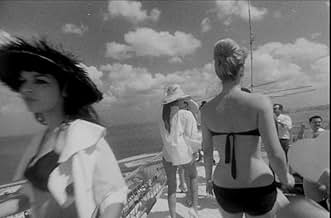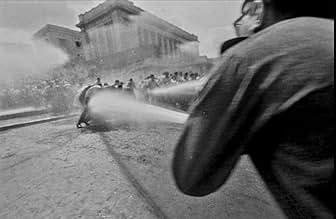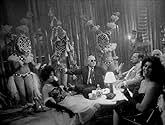Soy Cuba
- 1964
- Tous publics
- 2h 21m
IMDb RATING
8.2/10
12K
YOUR RATING
Four vignettes about the lives of the Cuban people set during the pre-revolutionary era.Four vignettes about the lives of the Cuban people set during the pre-revolutionary era.Four vignettes about the lives of the Cuban people set during the pre-revolutionary era.
- Director
- Writers
- Stars
- Awards
- 2 wins & 1 nomination total
Mario González Broche
- Pablo
- (as Mario González)
- Director
- Writers
- All cast & crew
- Production, box office & more at IMDbPro
Featured reviews
I am Cuba/Soy Cuba features the stories of several Cuban citizen-types: a young prostitute, a farmer, a young revolutionary and so on, up to the start of the island's Castro Revolution.
If this sounds dull, then rest assured that the plot is minimal and, despite it's avowedly political purpose, hardly gets in the way of the film's main attractions today. What distinguishes the production is the cinematography. It is not an exaggeration to say that the images and technique in the film are breathtaking, and it is a tour-de-force of bravura camera work. Apparently Martin Scorcese has screened this film privately to work out how such-and-such a shot was achieved, and perhaps it's influence can be found in the famous through-the-kitchens tracking shot in 'Goodfellas'.
This is a film where the camera is constantly in motion, with sweeping balletic long takes, crane and hand held shots, tracking shots, including some over and down the side of buildings, through cane fields, into swimming pools, around packed night clubs, even hovering and moving along high over a street in the middle of a packed funeral procession - all without the usual cutting. I estimate the average length of a take in this film at about 2 - 3 minutes, a figure rare and astonishing these days, even with the benefit of steadicams - but jaw dropping given the still-unwieldy equipment they were surely using in 1964. In particular one or two large scale sequences must have taken days, if not weeks, to prepare, and presumably needed government marshaling to choreograph. (Ironically, whether or not the film makers intended it, the liberated camera work on display here reflects the notion of revolutionary freedom far more than the actual story vignettes.)
The film itself is shot in high contrast gleaming black and white, favouring wide angle lenses, and with a constant deep focus that reminded me of Greg Toland's work for Welles or some of James Wong Howes' work. Kalatozov's use of a handful of character 'types' throughout recalls Eisenstein's (and in fact there is a faint reference to his the Odessa Steps sequence in 'Battleship Potemkin' at one point when the revolutionary rioters march down some steps), but the effect here is far more sensual and lyrical. (Among the professional actors, Sergio Corrieri also appears in the better-known Memories of Underdevelopment). The film's 'artiness' is undeniably a distraction from the message of struggle, and to the original viewers the beautiful images must have been a long way from reality in the New Cuba.
Today we don't have this problem and the viewer is left with a visual feast to enjoy over and over again..
If this sounds dull, then rest assured that the plot is minimal and, despite it's avowedly political purpose, hardly gets in the way of the film's main attractions today. What distinguishes the production is the cinematography. It is not an exaggeration to say that the images and technique in the film are breathtaking, and it is a tour-de-force of bravura camera work. Apparently Martin Scorcese has screened this film privately to work out how such-and-such a shot was achieved, and perhaps it's influence can be found in the famous through-the-kitchens tracking shot in 'Goodfellas'.
This is a film where the camera is constantly in motion, with sweeping balletic long takes, crane and hand held shots, tracking shots, including some over and down the side of buildings, through cane fields, into swimming pools, around packed night clubs, even hovering and moving along high over a street in the middle of a packed funeral procession - all without the usual cutting. I estimate the average length of a take in this film at about 2 - 3 minutes, a figure rare and astonishing these days, even with the benefit of steadicams - but jaw dropping given the still-unwieldy equipment they were surely using in 1964. In particular one or two large scale sequences must have taken days, if not weeks, to prepare, and presumably needed government marshaling to choreograph. (Ironically, whether or not the film makers intended it, the liberated camera work on display here reflects the notion of revolutionary freedom far more than the actual story vignettes.)
The film itself is shot in high contrast gleaming black and white, favouring wide angle lenses, and with a constant deep focus that reminded me of Greg Toland's work for Welles or some of James Wong Howes' work. Kalatozov's use of a handful of character 'types' throughout recalls Eisenstein's (and in fact there is a faint reference to his the Odessa Steps sequence in 'Battleship Potemkin' at one point when the revolutionary rioters march down some steps), but the effect here is far more sensual and lyrical. (Among the professional actors, Sergio Corrieri also appears in the better-known Memories of Underdevelopment). The film's 'artiness' is undeniably a distraction from the message of struggle, and to the original viewers the beautiful images must have been a long way from reality in the New Cuba.
Today we don't have this problem and the viewer is left with a visual feast to enjoy over and over again..
Every frame of this film deserves to be printed, framed and hung in a gallery. And the sound, wow. The sound... Crunchy super-intimate sounds- like the sound of machetes ringing in the cane field- are as evocative as the images.
1964. It's amazing how much can be done with so little...
1964. It's amazing how much can be done with so little...
Is this the best film ever made? For me today in its afterglow it is.
I'm so fickle. I think if all else were equal, I'll always take embodied, real cinema that is coherently integrated. The way of telling the story is ideally complex and folded, using tricks to make the story matter. But if the storytelling is less spectacular, as long as the thing engages, that's what matters. If it changes me, its art and important, regardless of whether I can tell a good story about the storytelling.
That's the way I prefer. But sometimes the storytelling is so spectacular, so engaging in itself, that it doesn't matter what the story is. These are rare, because after all, you need the touch to change your life. So a filmmaker as unsophisticated and unattractive as, say Elia Kazan, can modify my existence when partnered with Williams and Brando.
And this story... what is conveyed here is mostly lies. Or rather it is a target story that is transparently bankrupt. Its based on an embodied reality of sorts. But its a twisted vision. The racism is palpable. The superiority of the European eye and mind are overwhelming. The simple notion of good and evil is less nuanced than in Star Wars or its predecendent westerns, and is intolerable. (This may be simply because history advises that both the Soviet and Cuban experiments were more brutal than what they replaced.)
But what cinema! What life! Just inhabiting this world has adjusted my imagination and dreams. The focus is usually on the extraordinary flying camera, because its so obvious, striking. It is, and if it were just that, I would still get you out of bed and across town to see this. But the flying eye is integrated with an architectural expression that is far deeper. The actors and camera move through buildings, fire, smoke, cane, trees, exploding dirt. This is as amazing the first time, just in wondering how they did it. Knowing the technology used, it seems impossible, and that knowledge actually distracts. You have to see this several times to just get past the wonder at the talking dog.
Then you can get into the visual poetry of thing. It isn't about people at all. They matter not at all except as fodder for ennobling posters. What matters is the structure of the forces that surround and channel them here and there like turbulent banks. This is a project centered on those forces, incarnated as spatial forces. Where in another project you wonder how a dog can be so dramatic, here you wonder how the director was able to control fire and smoke to be so perfectly compliant. Its not embodied in the story, which is daft, but in the real world that contains it.
This is absolutely in the spirit of Tarkovsky, and is the only film I know that betters him visually. Its less human, but oh so spatial. You must, must see it.
Ted's Evaluation -- 4 of 3: Every cineliterate person should experience this.
I'm so fickle. I think if all else were equal, I'll always take embodied, real cinema that is coherently integrated. The way of telling the story is ideally complex and folded, using tricks to make the story matter. But if the storytelling is less spectacular, as long as the thing engages, that's what matters. If it changes me, its art and important, regardless of whether I can tell a good story about the storytelling.
That's the way I prefer. But sometimes the storytelling is so spectacular, so engaging in itself, that it doesn't matter what the story is. These are rare, because after all, you need the touch to change your life. So a filmmaker as unsophisticated and unattractive as, say Elia Kazan, can modify my existence when partnered with Williams and Brando.
And this story... what is conveyed here is mostly lies. Or rather it is a target story that is transparently bankrupt. Its based on an embodied reality of sorts. But its a twisted vision. The racism is palpable. The superiority of the European eye and mind are overwhelming. The simple notion of good and evil is less nuanced than in Star Wars or its predecendent westerns, and is intolerable. (This may be simply because history advises that both the Soviet and Cuban experiments were more brutal than what they replaced.)
But what cinema! What life! Just inhabiting this world has adjusted my imagination and dreams. The focus is usually on the extraordinary flying camera, because its so obvious, striking. It is, and if it were just that, I would still get you out of bed and across town to see this. But the flying eye is integrated with an architectural expression that is far deeper. The actors and camera move through buildings, fire, smoke, cane, trees, exploding dirt. This is as amazing the first time, just in wondering how they did it. Knowing the technology used, it seems impossible, and that knowledge actually distracts. You have to see this several times to just get past the wonder at the talking dog.
Then you can get into the visual poetry of thing. It isn't about people at all. They matter not at all except as fodder for ennobling posters. What matters is the structure of the forces that surround and channel them here and there like turbulent banks. This is a project centered on those forces, incarnated as spatial forces. Where in another project you wonder how a dog can be so dramatic, here you wonder how the director was able to control fire and smoke to be so perfectly compliant. Its not embodied in the story, which is daft, but in the real world that contains it.
This is absolutely in the spirit of Tarkovsky, and is the only film I know that betters him visually. Its less human, but oh so spatial. You must, must see it.
Ted's Evaluation -- 4 of 3: Every cineliterate person should experience this.
It goes without saying that this movie includes some of the most breathtaking camera-work ever seen. Many scenes will live long in the memory of anyone who's been fortunate enough to see it. But it seems to be downgraded in many peoples minds by the notion of it being a propaganda movie.
I think its misleading to think of the movie as being 'propaganda' any more than most mainstream movies can be seen as propaganda for a particular way of life or viewpoint. The portrayal of the American characters in I Am Cuba is in many ways more fair-minded than numerous Hollywood or British movies (in the case of James Bond) in the portrayal of Communists or any other perceived enemy. Even anti war movies such as Platoon or Saving Private Ryan frequently portray the 'enemy' as faceless figures who are killed without a thought.
I prefer to see this movie as a love letter to Cuba by some brilliant (but undoubtedly naive) Soviet film makers. The storyline is much more sophisticated and innovative than has been given credit. Many of the characters are stereotypes, but they are still sympathetic and real. The movie is by no means perfect, but to dismiss it as beautiful propaganda is i think to underestimate the skill and thoughtfulness of the team who made it. By overemphasizing the origin of the movie has I think killed the enjoyment of it for many viewers. Just go see it and enjoy the sumptuous imagery. If you want to dismiss it as propaganda, fine, but if it to be seen as propaganda, then so is most of Hollywoods output.
I think its misleading to think of the movie as being 'propaganda' any more than most mainstream movies can be seen as propaganda for a particular way of life or viewpoint. The portrayal of the American characters in I Am Cuba is in many ways more fair-minded than numerous Hollywood or British movies (in the case of James Bond) in the portrayal of Communists or any other perceived enemy. Even anti war movies such as Platoon or Saving Private Ryan frequently portray the 'enemy' as faceless figures who are killed without a thought.
I prefer to see this movie as a love letter to Cuba by some brilliant (but undoubtedly naive) Soviet film makers. The storyline is much more sophisticated and innovative than has been given credit. Many of the characters are stereotypes, but they are still sympathetic and real. The movie is by no means perfect, but to dismiss it as beautiful propaganda is i think to underestimate the skill and thoughtfulness of the team who made it. By overemphasizing the origin of the movie has I think killed the enjoyment of it for many viewers. Just go see it and enjoy the sumptuous imagery. If you want to dismiss it as propaganda, fine, but if it to be seen as propaganda, then so is most of Hollywoods output.
That I've ever seen, and I watch a lot of movies. The story is propaganda, to be sure, and some of the acting is horrible, but WOW! I couldn't take my eyes off of it. Shot after stunning shot....I don't know how they did it, but I didn't mind all the rhetoric because I kept thinking, "Look, that's so beautiful" and "Wow, how did they do that?" I do recommend it also as a historical document of a time most people don't remember....I was born the year it was made and remember "the Communist Threat" but I think a lot of people younger than myself may not remember.
Not to mention that yes, some of the music was also amazing. A must see for any serious film buff.
Not to mention that yes, some of the music was also amazing. A must see for any serious film buff.
Did you know
- TriviaThe now famous long take that begins at the top of the hotel, then winds around and down into the swimming pool, originally come out of the water and continued. The camera was hand held, passed from crew member to crew member, to make its way down the side of the hotel into the pool. The camera lens had been equipped with a high speed, spinning glass disk taken from a submarine periscope. The spinning disk was installed to fling water drops off of the lens when the camera emerged from the swimming pool at the end of the shot. Much to the disappointment of the camera crew, director Mikhail Kalatozov cut the end of the take, ending it underwater.
- GoofsWhen Enrique gets to the top of the high-rise building he gains access to the roof by stepping through a window with a broken pane of glass. When he returns, the pane in same window is unbroken.
- ConnectionsFeatured in Soy Cuba, O Mamute Siberiano (2004)
- SoundtracksLoco amor
(Spanish-speaking adaptation of the 1958 song "Crazy Love")
Music and lyrics by Paul Anka
Performed by El Duo Los Diablos (as Los Diablos Demonicos)
Added accompaniment music recorded later at the Prado 210 studio
With Chucho Valdés (piano), Guillermo Barreto (drums) and Orlando "Cachaito" Lopez (bass).
- How long is I Am Cuba?Powered by Alexa
Details
- Release date
- Countries of origin
- Official site
- Languages
- Also known as
- Je suis Cuba
- Filming locations
- Calle M & 23 Ave, Havana, Cuba(rooftop scene: Enrique as a sniper)
- Production companies
- See more company credits at IMDbPro
Box office
- Gross US & Canada
- $168,100
- Gross worldwide
- $274,098
- Runtime2 hours 21 minutes
- Color
- Sound mix
- Aspect ratio
- 1.37 : 1
Contribute to this page
Suggest an edit or add missing content
























